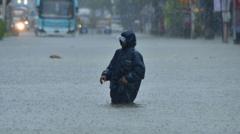The torrential downpour has resulted in knee-deep flooding in numerous areas, immobilizing the city's infrastructure and leading to mass cancellations of flights and train services. In a dramatic response, authorities rescued nearly 600 individuals trapped on a crowded monorail that stopped mid-journey, with some needing medical assistance for suffocation. The continuous rain has forced schools and colleges to close, and around 350 residents from low-lying areas have been relocated to temporary shelters.
The India Meteorological Department issued a red alert for the region, expecting further heavy rainfall on Wednesday, though improved conditions are anticipated later in the week. Maharashtra typically experiences monsoon rains during this season, but this year's rainfall has been exceptional, exceeding 800mm in just four days—a significant leap from the average August totals. Tragically, at least 21 lives have been lost due to rain-related incidents this week alone.
Disruptions have also been felt in the city's local train network, vital for millions of commuters, with considerable delays reported. Passengers are left stranded on platforms, waiting for services that are either postponed or rerouted. Flight operations at the international airport are similarly compromised, with budget airline IndiGo warning travelers of potential delays due to weather conditions.
A particular incident drew attention when a monorail, said to be overloaded, ceased functioning mid-track. Passengers reported suffocating conditions as air-conditioning failed, prompting emergency services to evacuate them using cranes. Initial findings indicated that overcrowding may have led to the malfunction, which has raised questions about safety protocols.
Political leaders have criticized the government's response to the disaster. Opposition figures have highlighted a perceived failure in preparedness, condemning the lack of effective planning despite the forewarnings given with the red alerts. Social media users echoed these sentiments, bemoaning the city's aging infrastructure and inadequate drainage systems despite recent upgrades.
As over 12 million people inhabit Mumbai, with many migrants arriving for better opportunities, the urgent need for sustainable infrastructure solutions is becoming increasingly apparent amidst the mounting challenges posed by extreme weather events.
The India Meteorological Department issued a red alert for the region, expecting further heavy rainfall on Wednesday, though improved conditions are anticipated later in the week. Maharashtra typically experiences monsoon rains during this season, but this year's rainfall has been exceptional, exceeding 800mm in just four days—a significant leap from the average August totals. Tragically, at least 21 lives have been lost due to rain-related incidents this week alone.
Disruptions have also been felt in the city's local train network, vital for millions of commuters, with considerable delays reported. Passengers are left stranded on platforms, waiting for services that are either postponed or rerouted. Flight operations at the international airport are similarly compromised, with budget airline IndiGo warning travelers of potential delays due to weather conditions.
A particular incident drew attention when a monorail, said to be overloaded, ceased functioning mid-track. Passengers reported suffocating conditions as air-conditioning failed, prompting emergency services to evacuate them using cranes. Initial findings indicated that overcrowding may have led to the malfunction, which has raised questions about safety protocols.
Political leaders have criticized the government's response to the disaster. Opposition figures have highlighted a perceived failure in preparedness, condemning the lack of effective planning despite the forewarnings given with the red alerts. Social media users echoed these sentiments, bemoaning the city's aging infrastructure and inadequate drainage systems despite recent upgrades.
As over 12 million people inhabit Mumbai, with many migrants arriving for better opportunities, the urgent need for sustainable infrastructure solutions is becoming increasingly apparent amidst the mounting challenges posed by extreme weather events.





















